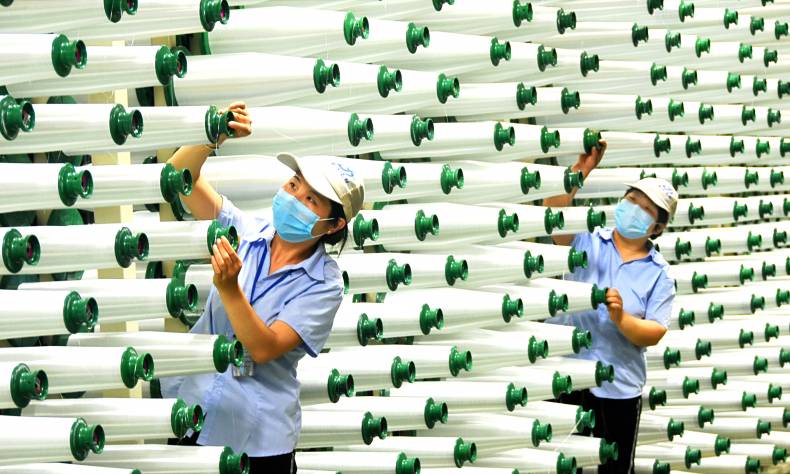
Unstoppable Industrial Upgrade
This year, the U.S. has persistently exerted trade friction on China, which eventually triggered the first shots of a total trade war. Additionally, the U.S. has targeted the Made in China 2025 strategy.
By Shi Dan
This year, the U.S. has persistently exerted trade friction on China, which eventually triggered the first shots of a total trade war. Additionally, the U.S. has targeted the Made in China 2025 strategy, deeming China’s aspirations to catch up with the technologies of developed countries and taking over global high-end manufacturing an “economic invasion” of the U.S. This accusation neglected objective law of industrial development, and the measures it prompts will heavily damage global economic order and the industrial division system.
Since the 1980s, thanks to its reform and opening-up as well as low labor costs, China has developed a friendly business environment that has attracted a massive chunk of global manufacturing, greatly improving the country’s industrial production system and increasing its production capacity. Eventually dubbed the “world factory,” China has enriched the supply of industrial products worldwide, benefiting the entire planet. Trade between China and U.S. shifted from deficit to surplus with the dramatic changes in trade structure: China exports mostly manufactured goods especially electronic commodities to the U.S. while importing agricultural products like soybeans.
The trade relations and structure between the two countries have resulted from their respective industrial competitiveness and comparative advantages. When the division of labor in global manufacturing transferred from industries to commodities, China’s comparative advantage became prominent with stronger competitiveness in manufacturing low and middle-end products than the U.S. and European countries. This has expanded China’s market share rapidly. Relatively speaking, the U.S. and European countries lacked comparative advantages in some manufacturing sectors. And during global industrial transfer and re-division of labor, Chinese enterprises took over manufacturing and processing from U.S. and European companies, freeing them up to focus more resources on high value-added production chain steps like design and marketing, which facilitated the U.S. and European countries in their transfer to service-oriented economies.
In the past decades, due to economic globalization and technological progress, the global division of labor starkly contrasts the relatively recent past. Further division of the industrial chain has led to one product being manufactured and built in many countries. A large proportion of intermediate goods composing commodities exported from China to the U.S. are imported from other countries including the U.S itself. Such industrial division enables each country to optimize their comparative advantages and focus on specialized production, which has contributed to unprecedented prosperity of the world economy.
China’s manufacturing is mostly low and middle-end products that exert tremendous pressure on the country’s environment. China’s manufacturing needs to evolve to a new stage corresponding to its rising labor costs. The Made in China 2025 strategy was thus designed to facilitate such an upgrade in accordance with objective laws of industrial development.
The adjustment of global industrial division objectively demands involved countries accordingly adjust their economic and social structures as well as patterns of income distribution. But during the industrial transfer of multinational corporations, the U.S. government has not handled well the issues like employment and wealth distribution, causing great trouble in the country. The Trump administration blames internal struggles on the conflicts with China and ignored WTO regulations to launch a trade war targeting Made in China 2015. However, a trade war cannot solve American domestic problems and will only hinder the economic development of the world.
Made in China 2025 development strategy endeavors to solve problems plaguing Chinese manufacturing like modest product quality, rising labor costs, dense resource consumption and costly environmental pollution. Solving these problems will not harm other countries’ interests, but improve the level and quality of global industrial division and cooperation while making constant contributions to the world. Over the past four decades since China implemented reform and opening up, the country has gradually become more involved in global affairs and developed its economy by following international rules and norms, becoming a major driver of world economic growth. Oppressing the development of China—an emerging economy—is akin to dragging world economic advance. Donald Trump seeks unilateral trade protectionism in an effort to change the established development track of global industrial division and lower the efficiency of it. This runs contrary to the objective law of global industrial development and harms both sides.
If the U.S. stops exporting high-tech to China and slaps tariffs on imported Chinese commodities, Chinese enterprises will only be impacted in the short term. In a long run, running contrary to the trend of globalization, Washington’s move will eventually damage the interests of American enterprises and people. The U.S. cannot stop China from transferring and upgrading its manufacturing industry because the drive is rooted in Chinese people’s aspirations for better lives. Innovation is becoming the driving force of China’s economy. Following the objective law of industrial development, Made in China 2025 presents a roadmap for China to accelerate technological innovation in manufacturing and outlines policies and a system to fully utilize the market economy laws to encourage enterprises’ technology input and innovation. China attaches great importance to intellectual property rights (IPR) protection, which is also an important part in implementing Made in China 2025 and in building an innovation-oriented country. China has constructed and continued to improve its legal system for IPR. With its huge market, solid industrial system, innovation-oriented development and strict IPR protection, China’s industrial upgrade will not be stopped by outside forces.
Source: China Pictorial
This author is a researcher at the Institute of Industrial Economics of Chinese Academy of Social Sciences.
Opinion articles reflect the views of their authors, not necessarily those of China Focus
 Facebook
Facebook
 Twitter
Twitter
 Linkedin
Linkedin
 Google +
Google +










